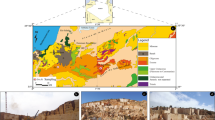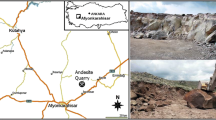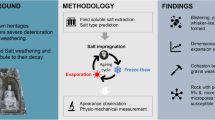Abstract
The study investigated the long-term performance/durability of yellow travertine against various environmental processes using several accelerated weathering tests: wet–dry, freeze–thaw and salt crystallization. Prior to the accelerated weathering tests, the specimens were separated into two groups based on their porosities. The re-crystallization pressure of Na2SO4 salt was found to be the most destructive factor in the deterioration of the yellow travertine, with a maximum of 50% loss of integrity recorded. The recurrent cycles of wetting–drying and freezing–thawing caused relatively minor damage. After the experimental studies, the disintegration rate was statistically evaluated using the alteration index–alteration velocity and the decay function approaches. Both statistical models confirmed that the rate of disintegration was higher with salt re-crystallization pressures in the less porous yellow travertines compared with that resulting from wet–dry and freeze–thaw cycles.
Résumé
L’étude s’est intéressée aux performances à long terme et la durabilité de travertins jaunes soumis à différentes sollicitations d’altération météorique simulées par des essais accélérés : humidification-séchage, gel-dégel et cristallisation de sels. Avant la réalisation de ces tests accélérés, les échantillons ont été répartis en deux groupes en fonction de leurs porosités. Le développement de pressions de recristallisation de sel de Na2SO4 s’est avéré être le processus le plus destructeur pour les travertins jaunes, avec jusqu’à 50% de perte d’intégrité enregistrée. Les cycles successifs d’humidification-séchage et de gel-dégel ont causé des dommages relativement faibles. Après les études expérimentales, le taux de désintégration a été statistiquement évalué en s’appuyant sur les mesures d’indice d’altération et de vitesse d’altération ainsi que sur une fonction de décomposition du matériau. Ces deux modèles statistiques ont confirmé que, pour les travertins jaunes les moins poreux, le taux de désintégration était plus élevé en cas de développement de pressions de recristallisation de sel, comparé au cas des cycles d’humidification-séchage et de gel-dégel.















Similar content being viewed by others
References
Akin M (2008) Investigation of deterioration of Eskipazar (Karabuk) travertines. PhD thesis, Ankara University, Graduate School of Natural and Applied Sciences, Ankara, Turkey (in Turkish, unpublished)
Akin M (2010) A quantitative weathering classification system for yellow travertines. Environ Earth Sci. doi:10.1007/s12665-009-0319-7 (in press)
Altındağ R, Ayyıldız IS, Onargan T (2004) Mechanical property degradation of ignimbrite subjected to recurrent freeze-thaw cycles. Int J Rock Mech Min Sci 41:1023–1028
Angeli M, Bigas JP, Menendez B, Hebert R, David C (2006) Influence of capillary properties and evaporation on salt weathering of sedimentary rocks. Heritage weathering and conservation. Taylor&Francis/Balkema, Leiden, pp 253–259
Angeli M, Bigas JP, Benavente D, Menendez B, Hebert R, David C (2007) Salt crystallization in pores: quantification and estimation of damage. Environ Geol 52:187–195
ASTM (1992) Standard test method for evaluation of durability of rock for erosion control under wetting and drying conditions, D5313. Annual Book of ASTM Standards, American Society for Testing and Materials, West Conshocken, PA, pp 1347–1348
Bell FG (1993) Engineering geology. Blackwell, Oxford, pp 1–359
Benavente D, Garcı′a del Cura MA, Fort R, Ordonez S (2004) Durability estimation of porous building stones from pore structure and strength. Eng Geol 74:113–127
Benavente D, Cueto J, Martinez N, Garcı′a del Cura MA, Canaveras JC (2007) The influence of petrophysical properties on the salt weathering of porous building rocks. Environ Geol 52:197–206
Binal A, Kasapoğlu KE, Gökçeoğlu C (1997) The surficial physical deterioration behaviour of Neogene volcano-sedimentary rocks of Eskişehir-Yazılıkaya, NW Turkey. In: Proceedings of the international symposium on engineering geology and environment, vol 3. Athens, Greece. A.A. Balkema, Rotterdam, pp 3065–3069
Blows JF, Carey PJ, Poole AB (2003) Preliminary investigations into Caen Stone in the UK; its use, weathering and comparison with repair stone. Build Environ 38:1143–1149
Cooke RU (1994) Salt weathering and the urban water table in deserts. In: Robinson DA, Williams RBG (eds) Rock weathering and landform evolution, chap 12, pp 193–205
Flatt RJ (2002) Salt damage in porous materials: how high supersaturations are generated. J Cryst Growth 242:435–454
ISRM (1981) Rock characterization, testing and monitoring. In: Brown ET (ed) International society of rock mechanics suggested methods. Pergamon Press, Oxford, pp 1–211
Jefferson DP (1993) Building stone: the geological dimension. Q J Eng Geol 26:305–319
Mahmutoğlu Y, Yüzer E, Suner F, Eriş I, Eyüboğlu R (2003) Deterioration and conservation of the Dolmabahçe Palace (Istanbul) building stones. In: Yuzer E, Ergin H, Tugrul A (eds) Proceedings of industrial minerals and building stones, IMBS 2003, pp 343–352
Martin L, Bello MA, Martin A (1992) Accelerated alteration tests on the stones used in the cathedral of Granada (Spain). In: Delgado RJ, Henriques F, Telmo JF (eds) Proceedings of 7th international congress on deterioration and conservation of stone, Lisboa, Portugal, vol 2, pp 845–850
Mutlutürk M, Altındağ R, Türk G (2004) A decay function model for the integrity loss of rock when subjected to recurrent cycles of freezing–thawing and heating–cooling. Int J Rock Mech Min Sci 41:237–244
Ondrasina J, Kirchner D, Siegesmund S (2002) Freeze–thaw cycles and their influence on marble deterioration: a long term experiment. In: Siegesmund S, Weiss T, Vollbrecht A (eds) Natural stone, weathering phenomena, conservation strategies and case studies. Geological Society, London, Special Publications, vol 205, pp 9–18
Papida S, Murphy W, May E (2000) Enhancement of physical weathering of building stones by microbial populations. Int Biodeterior Biodegradation 46:305–317
Park HD, Kim SS, Chon HT (1998) Durability of ornamental stone exposed to various weathering environments in Korea. In: Moore DP, Hungr O (eds) Proceedings of 8th international congress of IAEG, vol 4, Balkema, Vancouver, pp 2953–2955
Pentecost A (2005) Travertine. Springer, Berlin, pp 1–445
Pitzurra L, Moroni B, Nocentini A, Sbaraglia G, Poli G, Bistoni F (2003) Microbial growth and air pollution in carbonate rock weathering. Int Biodeterior Biodegradation 52:63–68
Prikryl R (2001) Some microstructural aspects of strength variation in rocks. Int J Rock Mech Min Sci Geomech Abstr 38(5):671–682
Prikryl R, Lokajícek T, Svobodová J, Weishauptová Z (2003) Experimental weathering of marlstone from Prední Kopanina (Czech Republic)—historical building stone of Prague. Build Environ 38(9–10):1163–1171
RILEM (1980) Recommended tests to measure the deterioration of stone and to assess the effectiveness of treatment methods. Commission 25-PEM, material and structures, vol 13, pp 175–253
Ruedrich J, Siegesmund S (2007) Salt and ice crystallization in porous sandstones. Environ Geol 52:343–367
Ruiz Agudo E, Mees F, Jacobs P, Rodriguez Navarro C (2007) The role of saline solution properties on porous limestone salt weathering by magnesium and sodium sulfates. Environ Geol 52:305–317
Schneider C, Ziesch J, Bauer J, Török A, Siegesmund S (2008) Bauwerkskartierung zur Analyse des Verwitterungszustands an den Außenmauern des Schlosses von Buda (Budapest, Ungarn). Schriftenreihe der Deutschen Geologischen Gesellschaft (SDGG) 59:219–235
Sidraba I (2006) Weatherability of Roman travertine. PhD thesis, Riga Technical University Faculty of Material Science and Applied Chemistry Institute of Silicate Materials, Latvia (unpublished)
Sidraba I, Normandin KC, Cultrone G, Scheffler MJ (2004) Climatological and regional weathering of Roman travertine. In: Prikryl R, Siegel P (eds) Architectural and sculptural stone in cultural landscape. Carolinum Press, Prague, pp 211–228
Sousa LMO, Del Rio LMS, Calleja L, De Argandona VGR, Rey AR (2005) Influence of microfractures and porosity on the physico-mechanical properties and weathering of ornamental granites. Eng Geol 77:153–168
Steiger M (1996) Distribution of salt mixtures in a sandstone monument: sources, transport and crystallization properties. In: Zezza F (ed) EC research workshop on origin, mechanisms and effects of salts on degradation of monuments in marine and continental environments. European Commission, Protection and Conservation of the European Cultural Heritage, Research Report 4, Bari, pp 241–246
Steiger M (2002) Salts and crusts. In: Brimblecombe P (ed) The effects of air pollution on the built environment. Air pollution reviews. Imperial College, London
Steiger M (2005) Crystal growth in porous materials-I: the crystallization pressure of large crystals. J Cryst Growth 282:455–469
Steiger M, Zeunert A (1996) Crystallization properties of salt mixtures: comparison of experimental results and model calculations. In: Riederer J (ed) Proceedings of 8th int congress on deterioration and conservation of stone, Berlin, pp 535–544
Topal T, Doyuran V (1998) Analyses of deterioration of the Cappadocian tuff, Turkey. Environ Geol 34(1):5–19
Topal T, Sözmen B (2003) Deterioration mechanisms of tuffs in Midas monument. Eng Geol 68:201–223
Török A (2004) Comparison of the processes of decay of two limestones in a polluted urban environment. In: Mitchell DJ, Searle DE (eds) Stone deterioration in polluted urban environments. Science Publishers, Enfield, pp 73–92
Török A (2006) Hungarian travertine: weathering forms and durability. In: Fort R, Alvarez de Buego M, Gomez-Heras M, Vazquez-Calvo C (eds) Heritage weathering and conservation, vol I. Taylor & Francis/Balkema, London, pp 199–204
Török A (2008) Black crusts on travertine: factors controlling development and stability. Environ Geol 56:583–584
TS699 (1987) Natural building stones, investigation and test methods. Turkish Standards Institute, Ankara, pp 1–82 (in Turkish)
TSEN12371 (2002). Natural stones-testing methods-determination of frost resistance. Turkish Standards Institute, Ankara (in Turkish)
Tuğrul A, Zarif İH (1999) Research on limestone decay in a polluting environment, İstanbul-Turkey. Environ Geol 38(2):149–158
Uchida E, Ogawa Y, Maeda N, Nakagawa T (1999) Deterioration of stone materials in the Angkor monuments, Cambodia. Eng Geol 55:101–112
Van TT, Beck K, Al-Mukhtar M (2007) Accelerated weathering tests on two highly porous limestones. Environ Geol 52:411–420
Yavuz AB, Topal T (2007) Thermal and salt crystallization effects on marble deterioration: examples from Western Anatolia, Turkey. Eng Geol 90:30–40
Yavuz H, Altındağ R, Saraç S, Uğur I, Şengün N (2006) Estimating the index properties of deteriorated carbonate rocks due to freeze–thaw and thermal shock weathering. Int J Rock Mech Min Sci 43:767–775
Yüzer E, Angı S (2005) Natural stone sector in Turkey special attention to Turkish travertines. In: Özkul M, Yağız S, Jones B (eds) Proceedings of 1st international symposium on travertine, Denizli, Turkey, pp 3–13
Zappia G, Sabbioni C, Riontino C, Gobbi G, Favoni O (1998) Exposure tests of building materials in urban atmosphere. Sci Total Environ 224:235–244
Acknowledgments
The authors would like to thank Prof. Dr. Baki Varol, Prof. Dr. Recep Kılıç, Prof. Dr. Reşat Ulusay, and Prof. Dr. Tamer Topal for their valuable comments and help throughout the entire study. This research was financially supported by Ankara University Scientific Research Project (Project Number: 2006-0745044).
Author information
Authors and Affiliations
Corresponding author
Rights and permissions
About this article
Cite this article
Akin, M., Özsan, A. Evaluation of the long-term durability of yellow travertine using accelerated weathering tests. Bull Eng Geol Environ 70, 101–114 (2011). https://doi.org/10.1007/s10064-010-0287-x
Received:
Accepted:
Published:
Issue Date:
DOI: https://doi.org/10.1007/s10064-010-0287-x




